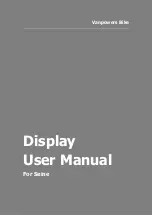
76
User's Guide Babyface Pro
© RME
25.6 General
•
Power supply: USB bus power or external power supply
•
Typical power consumption: 2.9 Watts
•
Max. power consumption: 4.6 Watts
•
Current at 5 V bus power operation: 600 mA (2.9 Watts)
•
Current at 12 V external power: 240 mA (2.9 Watts)
•
Dimensions (WxHxD): 108 x 35 x 181 mm (4.25" x 1.4" x 7.1")
•
Weight: 680 g ( 1.5 lbs)
•
Temperature range: +5° up to +50° Celsius (41° F up to 122°F)
•
Relative humidity: < 75%, non condensing
26. Technical Background
26.1 Lock and SyncCheck
Digital signals consist of a carrier and the data. If a digital signal is applied to an input, the re-
ceiver has to synchronize to the carrier clock in order to read the data correctly. To achieve this,
the receiver uses a PLL (Phase Locked Loop). As soon as the receiver meets the exact fre-
quency of the incoming signal, it is locked. This
Lock
state remains even with small changes of
the frequency, because the PLL tracks the receiver's frequency.
If an ADAT or SPDIF signal is applied to the Babyface Pro, the corresponding input LED starts
flashing. The unit indicates LOCK, i. e. a valid input signal (in case the signal is also in sync, the
LED is constantly lit, see below).
Unfortunately, LOCK does not necessarily mean that the received signal is correct with respect
to the clock which processes the read out of the embedded data. Example [1]: The Babyface
Pro is set to 44.1 kHz internally (clock mode Master), and a mixing desk with ADAT output is
connected to input ADAT. The corresponding LED will show LOCK immediately, but usually the
mixing desk's sample rate is generated internally (also Master), and thus slightly higher or lower
than the Babyface Pro's internal sample rate. Result: When reading out the data, there will fre-
quently be read errors that cause clicks and drop outs.
In order to display those problems optically at the device, the Babyface Pro includes
Sync-
Check
. It checks all clocks used for
synchronicity
. If they are not synchronous to each other
(i.e. absolutely identical) the SYNC LED flashes. In case they are completely synchronous the
LED is constantly lit. In the above example the user would have noticed quickly that the LED
kept on flashing after connecting the mixing desk.
The same information is presented in the Babyface Pro's Settings dialog. In the status display
Input State
the state of the input clock is decoded and shown as simple text (No Lock, Lock,
Sync).
In practice, SyncCheck allows for a quick overview of the correct configuration of all digital de-
vices. So one of the most difficult and error-prone topics of the digital studio world finally be-
comes easy to handle.
Содержание Babyface Pro
Страница 5: ...User s Guide Babyface Pro RME 5 User s Guide Babyface Pro General...
Страница 11: ...User s Guide Babyface Pro RME 11 User s Guide Babyface Pro Installation and Operation Windows...
Страница 28: ...28 User s Guide Babyface Pro RME...
Страница 29: ...User s Guide Babyface Pro RME 29 User s Guide Babyface Pro Installation and Operation Mac OS X...
Страница 38: ...38 User s Guide Babyface Pro RME...
Страница 39: ...User s Guide Babyface Pro RME 39 User s Guide Babyface Pro TotalMix FX...
Страница 41: ...User s Guide Babyface Pro RME 41...
Страница 73: ...User s Guide Babyface Pro RME 73 User s Guide Babyface Pro Technical Reference...
Страница 81: ...User s Guide Babyface Pro RME 81 27 Diagrams 27 1 Block Diagram Babyface Pro...
Страница 83: ...User s Guide Babyface Pro RME 83 User s Guide Babyface Pro Stand Alone and Class Compliant Mode...
Страница 91: ...User s Guide Babyface Pro RME 91 User s Guide Babyface Pro Miscellaneous...
















































